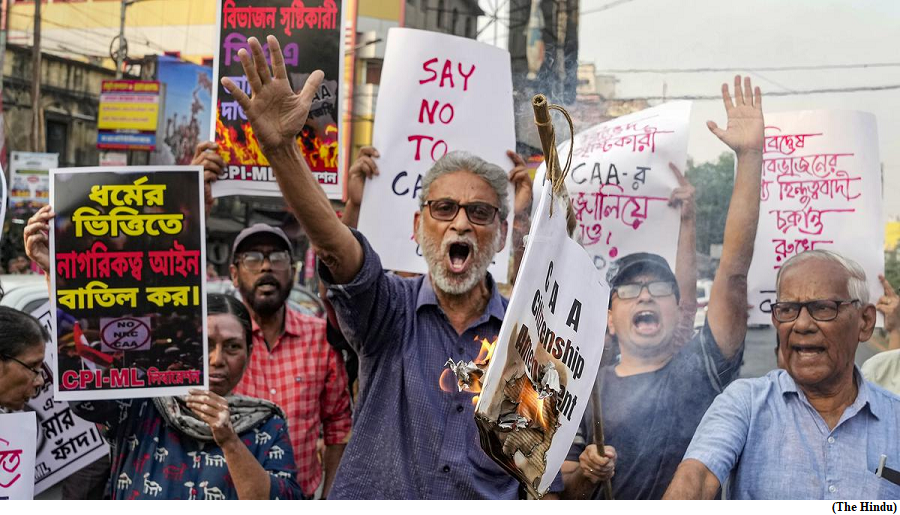CAA and status of judicial proceedings (GS Paper 2, Polity and Constitution)

Why in news?
- Four years after Parliament passed the Citizenship Amendment Act (CAA), 2019, the Ministry of Home Affairs (MHA) notified the rules to implement the law recently.
- It fast-tracks citizenship for undocumented immigrants from six non-Muslim communities; Hindu, Sikh, Buddhist, Parsi, Christian and Jain from Pakistan, Afghanistan and Bangladesh.
- The CAA is also under challenge before the Supreme Court, with several petitioners moving fresh pleas seeking a stay on the implementation of the rules.
What are the implications of CAA?
- In December 2019, Parliament passed an amendment to The Citizenship Act, 1955 (1955 Act) introducing a new proviso to Section 2(1)(b) which defines “illegal migrants.”
- Accordingly, undocumented immigrants who entered India on or before December 31, 2014, and whom the Central government has exempted under the Passport (Entry into India) Act, 1920, or the Foreigners Act, 1946, would be eligible for citizenship under the 1955 Act.
- However, certain tribal areas in Assam, Meghalaya, Mizoram, and Tripura were exempted from the legislation’s ambit. To access these protected areas, an Inner Line Permit (ILP) is needed from the concerned State governments.
NRIC & CAA:
- A key concern is that when viewed in combination with the proposed all-India National Register of Indian Citizens (NRIC), the CAA has the potential to disproportionately impact Muslims residing in India.
- In the event of people being excluded from NRIC, non-Muslims may have an opportunity to get included through the CAA, while it may be denied to Muslims. A Supreme Court-monitored National Register of Citizens that took place in Assam in 2021 left out over 19 lakh people from the citizenship register.
- On May 28, 2021, the Union government issued an order under Section 16 of the 1955 Act, granting District Collectors in five States with high migrant populations the power to grant citizenship to groups identified in the 2019 amendment.
Required documents:
- With the newly notified rules, the Centre has eased the process of granting Indian citizenship to members of the specified communities by excluding the requirement of a “valid passport” of their origin countries or a valid visa from India.
- Instead, “any document” that shows one of the parents, grandparents or even great-grandparents of the applicant was from one of these countries is sufficient to prove their nationality. Additionally, a certificate issued by an elected member of a local body can be a replacement for a visa.
Violation of Article 14:
- After the legislation’s enactment in 2019, the Indian Union Muslim League (IUML) filed a petition challenging its constitutionality, which was joined by close to 200 petitions. These petitions challenge the law for violating Article 14 of the Constitution by making religion a qualifier for citizenship.
- The CAA has also been dubbed as a move to subvert the Assam Accord of 1985 that deems any person who cannot prove his ancestry beyond March 24, 1971, as an alien and does not differentiate on grounds of religion.
- The petitions contend that the law will further multiply the “uncontrolled influx of illegal migrants from Bangladesh to Assam.”
How has the Supreme Court responded?
- Calling the CAA a “benign piece of legislation,” the Centre in its affidavit before the Supreme Court said that it seeks to provide amnesty to specific communities from specified countries with a clear cut-off date. It highlighted that the law does not in any manner affect the legal, democratic or secular rights of any Indian citizen.
- The affidavit further stated that the “narrowly tailored legislation” was passed to “tackle a specific problem, i.e., the persecution on the ground of religion in the light of the undisputable theocratic constitutional position in these specified countries, the systematic functioning of these States and the perception of fear that may be prevalent amongst minorities as per the de facto situation in these countries.”
- On December 18, 2019, a Bench comprising former Chief Justice of India (CJI) S.A. Bobde refused to stay the operation of the law and instead suggested that the government publicise the actual intent of the Act.
- On October 6, 2022, a Bench comprising former CJI U.U. Lalit passed an order stating that final hearings in the case would begin on December 6, 2022. However, the case has not been listed since then.
What is the significance of the challenge to Section 6A?
- The proceedings against the CAA are also dependent on the outcome of the challenge to Section 6A of the 1955 Act which was introduced in furtherance of a Memorandum of Settlement called the “Assam Accord” signed on August 15, 1985.
- In December 2023, a five-judge Constitution Bench led by CJI D.Y. Chandrachud reserved its verdict on the validity of Section 6A after orally observing that the provision was enacted as a humanitarian measure in the wake of the 1971 Bangladesh Liberation War and was deeply interwoven in the country’s history.
- Section 6A determines who is a foreigner in Assam by establishing March 24, 1971, as the cut-off date for entry, those who came to the State on or after January 1, 1966, but before March 25, 1971, were to be declared as “foreigners” and would have all the rights and obligations of Indian citizens except that they would not be able to vote for 10 years.
- If March 24, 1971, is upheld as a valid cut-off date for entry into the State, then CAA can be held to be violative of the Assam Accord since it establishes a different timeline.


